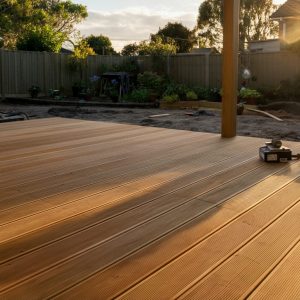
Building a deck is an exciting project that can add both value and enjoyment to your home. However, before you swing a hammer or lay the first board, it’s important to understand the deck codes that regulate construction. These codes ensure that your deck is safe, durable, and compliant with local regulations. Ignoring them could lead to costly penalties—or, worse, a structure that’s unsafe for use.
Here are essential deck codes you need to know and why hiring professionals, like the experienced team at Miles Bradley, is crucial for a smooth and successful deck installation.
Decks are often elevated or attached to homes, so safety is critical. Deck codes are established to minimize risks such as structural failure, fire hazards, or accidents. These codes typically address elements like frame strength, railing requirements, load capacities, and proper material usage. Deck codes protect both property owners and users, ensuring the structure is built to stand the test of time.
Failing to comply with these codes can lead to:
By understanding the rules upfront, you save yourself from financial headaches and potential safety risks down the line.
Before you dive head first into deck construction, you need to be aware of the deck codes that are relevant to your deck building. Here are important deck codes you need to know:
Before you start your deck installation, obtain the necessary building permits from your local municipality. Permits ensure that your project complies with local zoning laws and safety regulations. Skipping this step could lead to fines and, in some cases, having your deck torn down.
Deck footings are the foundation of your structure. To ensure stability, deck codes specify the depth and size of footings based on factors such as soil type and climate.
Every deck must support a minimum amount of weight safely. The two categories of load capacity are Live Load (temporary weight) and Dead Load (permanent weight). Failure to account for load capacities can lead to structural failure, especially during social gatherings or extreme weather conditions.
The materials you select for your deck should meet specific code requirements. For example:
Using substandard materials not only violates building codes but also decreases the lifespan of your deck.
While DIYing your new deck may sound like fun, the deck codes above are just the surface. In addition to other standard codes surrounding railings and stairs, there are state and local decking codes that need to be followed as well. This is where Miles Bradley comes in!
Miles Bradley is a full-service design and build custom deck and sunroom firm serving all of Michigan and Illinois including the entire Chicago Land area. In addition to being professional deckers who know all local and state decking codes, they have built their nationwide reputation on being an expert in low-maintenance decking and building products. If you looking for a new deck installation, contact Miles Bradley and see what we can do for you!

Even in the wintertime, you need to take measures to prevent your deck from becoming a hazard.
Although people rarely use their deck throughout the winter, it is still important that a homeowner does not neglect it. Injuries and accidents could occur on your deck making you liable, especially if you have been ignoring the upkeep. Winter creates conditions that will increase the likelihood of slips and falls. Here are some tips from Miles Bradley on how to prevent your deck from becoming a hazard.
Let’s start with the obvious things that will make your deck dangerous: ice and snow. While clearing the snow is easy enough, removing the ice is another story. Some people think that sprinkling grit salt is a good solution but this can be incredibly harmful to your deck. Due to composite decks having a high percentage of hardwood fibers inside, this abrasive material can mark up your deck quickly. This also applies to harsh anti-slip chemicals that can stain and discolor your deck.
Instead of relying on grit salt and harsh chemicals, the best way to remove ice is to use warm water. Just fill a bucket with warm water and pour it over the deck to melt away the ice build-up. Sometimes, there will be residue left, but that can be easily removed through cleaning. After applying the warm water, use a squeegee to remove the excess and a dry mop. Also, apply non-slip methods to ensure safety.
When it rains or snows, decks tend to become a slipping hazard. However, adding some non-slip mats and adhesive treads can be a great solution for that. These are affordable solutions to install that will prevent accidents. Treads and mats provide extra grip, reducing the chances of slipping and falling. In addition, mats come in a variety of styles allowing you to choose what is best for your deck.
Although it can be hard with winter snow and ice, you should do regular cleaning when the weather is right. While ice and snow are hazards, the biggest slipping hazard is the build-up of mildew and mold. Once the weather is good, use a hose or powerwash on a low setting to remove mold, debris, and other things that will make your deck hazardous!
Choosing your deck style is an important step before installing a new outdoor space or patio. For many people, deciding to build a new deck comes from needing to replace an old one. After all, keeping a deck that is rotting away is a safety hazard and an eyesore. So, if you are going to replace it, you need to think about the deck that is going to be built in its place. There are a variety of deck styles to choose from and a lot has to do with the space that is available to build the new deck. Miles Bradley would like to help you find the right deck and style right for you!
Before introducing some styles, there are few factors that you should consider when planning a deck. First of all, you want to consider the architecture of your house. Decks are very versatile but most people want their outdoor space to compliment their house. As mentioned, you’ll need to figure out the available space. If you are living in area with smaller lots like Dearborn, you’ll probably want to make sure the space doesn’t take up too much of the lot. In addition, what is the primary function of your outdoor space? Depending on if going to casual place to hangout or a way to provide extra living space.
When it comes to choosing your deck style, there are a lot of options to choose from. Here are some of the deck styles people use with their deck design.
Traditional
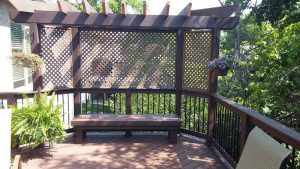
Sometimes, going with the classics is a right choice. Traditional decks are know for the versatility and having a certain level of elegance. Most of the time, these decks are perfect for extra features including multi-level decks and multi-color accents. Railing, deck lighting and under deck space design are all common when building a traditional deck.
Mid-Century
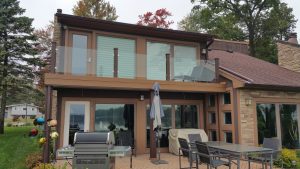
Mid-Century decks are known for their simple but trendy aesthetic. Most of these decks have geometric shapes to give a unified look. Mid-century decks also tend to lean towards a nature feel to compliment the natural textures in mid-century homes.
Farmhouse
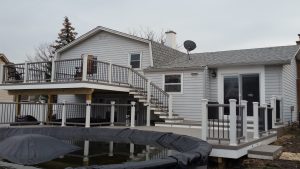
When people think of farmhouse decks, they immediately think about wraparound porches and decks. The outdoor areas can make a house feel bigger. It also offers easy access in and out due to the multiple access points to the deck. You also have multiple options to set your furniture or for a scenic view.
Scandinavian
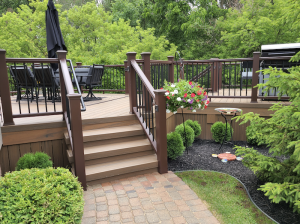
This deck style focuses on minimalist design with a neutral color scheme and natural materials. Scandinavian decks are typically lower to the ground and made to be simple in comparison to the other decks.
Building and designing a deck doesn’t have to be a chore. In fact, it should be fun! Miles Bradley experts will help you with your design and choices. No stress and Trex decks are a cornerstone of our business. Call or Contact us for help today!
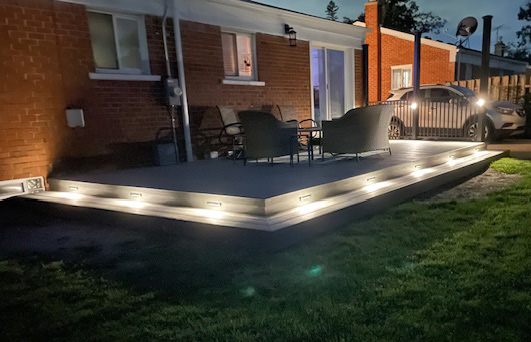
There are many decisions to be made when building a new deck or rebuilding an old one. You have to choose between decking materials, railings, adding an underdeck, and many other options. However, another thing you should be considering is deck lighting. While it might seem like something small, adding lighting can help enhance your deck in a variety of ways!
Adding some lighting to your decking can enhance your outdoor experience. Well-lit decks make it safer for people to move around in the late evening or at night. In addition to better safety, it allows you to extend the use of your deck. Lighting provides easy navigation, especially if you add them to the deck step and stairs. In addition, the lighting will showcase your property and enhance the mood and atmosphere. The best part is that you can make these lights energy-efficient by opting to use LED lights. LED (light emitting diode) lights are durable, long-lasting, and consume less energy compared to traditional incandescent bulbs or fluorescent lighting.
Adding lighting to your outdoor space can significantly enhance its functionality, safety, and ambiance. Here are some compelling reasons to add lighting to your deck.
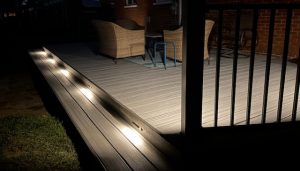 If you are interested in adding lighting to your new deck, then Miles Bradley can help you! We can put lights on your steps, rails, or posts on your deck. Adding attractive lighting provides decorative accents, and warm highlighting.
If you are interested in adding lighting to your new deck, then Miles Bradley can help you! We can put lights on your steps, rails, or posts on your deck. Adding attractive lighting provides decorative accents, and warm highlighting.
Step and rail lighting has many advantages not only is it a great enhancement for looks but is a safety advantage as well. As you can see from the picture, even though the lighting is subtle, the lights will help people see where they are walking and stepping down.
Our professional deck builders in the Metro Detroit area or Chicago, Illinois area can help you decide on the many choices of lighting; function, combination, style, size and layout!
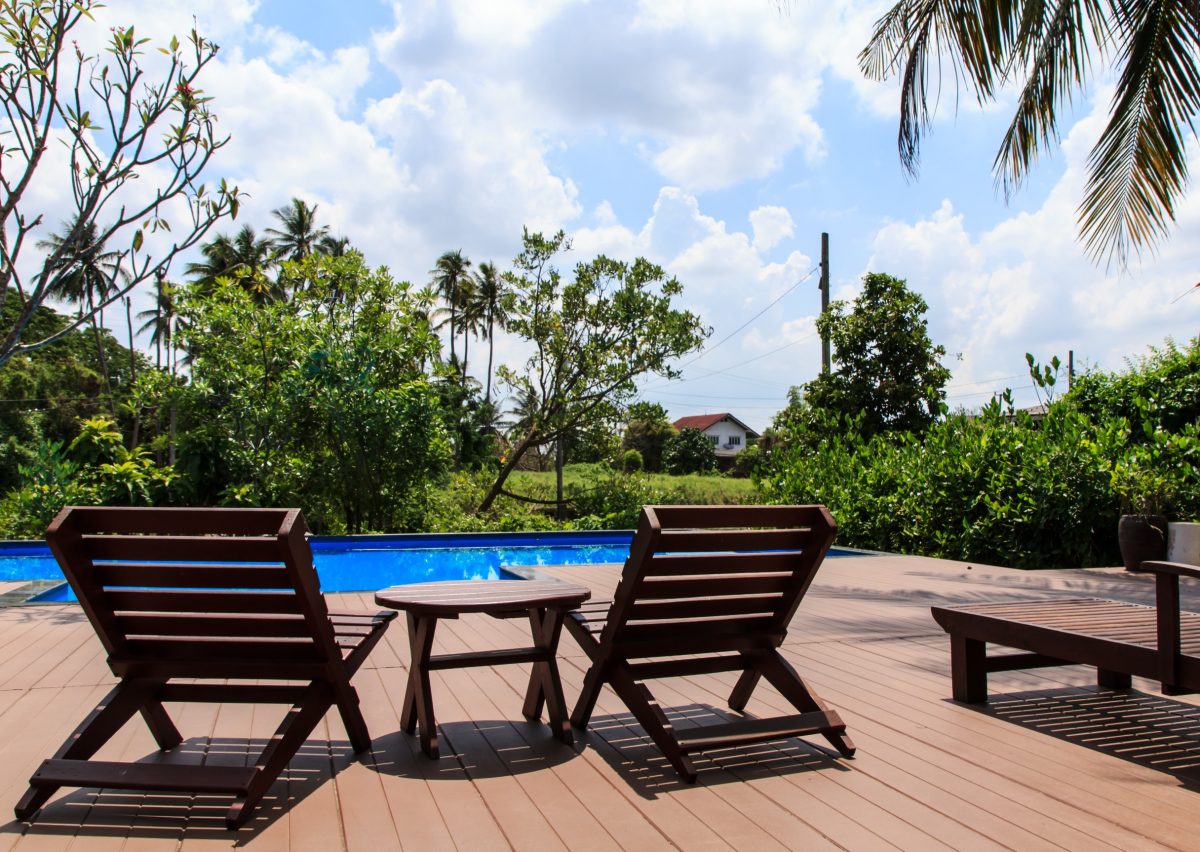
Owning a pool can be great, especially in the summertime. For many people, it’s a place to gather family and friends to have a great time. Pool owners often build decks around their pools for aesthetic and functional reasons. However, people do not realize that they could be causing damage to their decks. We know there are lots of things to take care of when caring for a pool including the pool toys, chemicals, temperature, cleaning, and safety but most people don’t think about the deck right beside the pool.
So, are your pool chemicals hurting your deck? The answer is probably. There are a lot of factors to consider before determining if your deck is being damaged by pool chemicals. The first factor is the type of material the deck is made out of. Many composite deck material like Trex tends to be more durable than standard wood decking. However, it doesn’t make them immune. The chemicals in pool water can damage the surface of both materials over time. Even if Trex is resistant to the damage, it still can become a problem if left alone. There are other things to consider as well such as foot traffic and sun exposure.
You might think that hot tubs might be safer due to their small size but they can be just as damaging. This is because of the chlorine and bromine used in hot tub water. Due to them being strong oxidizers, these chemicals can cause rot in your deck if you are not careful. With the pool water splashing on the deck, the sun beating down, and people in, out, and walking all over the deck through the summer it takes a toll on your deck. You will gradually see the color fade, cracks, holes, and the wood breaks down. But how do you avoid these outcomes?
To protect your pool, there are a few steps that you can take. One way to help with this wear and tear is to change what chemicals you’re using in your pool. There are many options for keeping your pool clean without using such harsh chemicals. We recommend talking with your local pool and spa supplier to get more info. Another way to keep your deck healthy is to clean your deck once a week to get rid of the build-up. If you have a wood deck, we recommend replacing it with composite wood for extra endurance.
If you need help repairing or replacing your deck, you can count on Miles Bradley! We can repair and give your deck a new coating to protect it from next year’s pool water damage. We can guide you on the best option for your deck:
Are you ready to repair or completely rebuild your pool deck? We do complete deck remodeling or repairs whatever your deck needs. Want another color? Style? Advice? Call TODAY 248-478-8660 serving Michigan and the Chicago Land area.